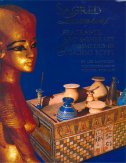
Book
Reviews
Book 20
Sacred Luxuries: Fragrance, Aromatherapy & Cosmetics in
Ancient Egypt

by Lisa Manniche with photographs by Werner Forman
Opus publishing Ltd 1999
ISBN 0-9535546-0-0
This is a lavishly illustrated 160 page, highly referenced edition from Lise
Manniche, Professor of Egyptology at Copenhagen University, already known for
her book An Ancient Egyptian Herbal. To illustrate the scope of the book,
it is divided into seven main chapters covering the subjects of Ingredients,
Scent in the Temple, Kyphi & Tiryac, Recipes for Luxury, Scent for Love
& Rebirth, Fragrant Remedies and the Art of Cosmetics. The author is
particularly blessed with a simple and direct writing style, which is easily
readable and communicates a deep well of excellently researched information.
This is coupled with the striking photography of Werner Forman whose talents
adorns every, or every other-, page throughout. One of the most remarkable
photographs is that of an unguent jar in the form of a monkey holding its young,
where the semi-translucent quality of the opaque yellow vessel is employed with
clever up-lighting to give the impression that the infant is within the
mother’s body.
With many perfumery and aromatherapy courses referring in passing to perfumes
of Ancient Egypt, Lise Manniche gives depth and insight into the subject, with,
for example, the chapter of Scent in the Temple examining in some considerable
detail the preparation of sacred materials such as Hekenu Ungent, Tisheps Ungent,
Madjet and Secret Min Ungent. Kyphi, perhaps the best-known Egyptian perfume,
pretty well merits a whole chapter, and the variations and reincarnations of
this perfume during its popularity from 1500 BC to 1300 AD are described.
However it must be said that in many cases exact details of the ingredients and
preparation of specific Egyptian perfumes (such as Metopion – a Galbanum
perfume) and not known. In these instances, the works of writers from other
civilisations such as Pliny, Discorides and Theophrastus have to be consulted to
shed any light on the subject.
This book is warmly recommended to students of Natural Perfumery and to those
interested in aroma matters more generally. And for those who might previously
have lain awake at night wondering why so much salt was used in the ancient Rose
perfume Rhodinon – some explanatory words to reflect upon…!
Copyright Tony Burfield 2004